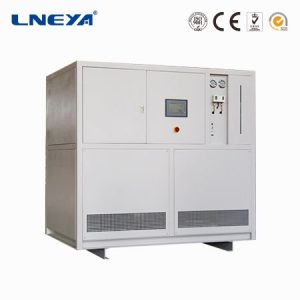Heating and cooling system for chemical reaction kettle reaction process
In the process of chemical chemical reaction, material temperature is an important production process parameter. For example, in salt crystallization, solution separation, organic pigment and intermediate processing, temperature control is particularly important. In order to achieve this goal, the reaction kettle is directly refrigerated and cooled, so as to achieve the purpose of indirectly reducing the temperature of the materials in the reaction kettle. For this reason, it is urgent to adopt suitable refrigeration equipment to lower the temperature of the reactor.

The heating and cooling system in the reaction process of the reactor is mainly used for cooling and cooling of the chemical reactor (chemical heat exchanger), and timely takes away the huge heat generated by the chemical reaction to achieve the purpose of cooling (cooling) and improve the quality of the product. The main heating and cooling system of the reactor reaction process is also called the chemical water chiller and the reactor water chiller, which are widely used in chemical and pharmaceutical industries.
In chemical production, because of the large refrigeration capacity, some tens of thousands of kcal per hour, there is a large demand for low-temperature refrigeration. The rate of most chemical exothermic reactions in the reactor cooling system will increase with increasing temperature and decrease with decreasing temperature. If the reaction temperature is lowered, the reaction will slow down, and the unreacted materials may accumulate in the reactor.
During the reaction, the temperature rises again, and the unreacted materials may start to react. If there are enough unreacted materials, the heat released by the reaction may exceed the cooling capacity of the reactor. In the selection of chiller equipment, chemical industry practitioners should pay special attention, otherwise it will cause refrigeration mismatch, high energy consumption, and even product quality problems, affect normal production, and increase enterprise operating costs.
Different types of production require different temperature conditions for the reactor to cool down. LNEYA provides room temperature reactor cooling, medium temperature reactor cooling, low temperature reactor cooling, cryogenic reactor cooling, etc., heating and cooling systems and temperature solutions for the reactor reaction process at various temperatures.
Related recommendations
-
Application of supporting experimental equipment for refrigeration and heating system
1209The mixing tank with jacket and insulation layer is a three-layer insulation mixing tank with heating function, which has the functions of heating, insulation, mixing, etc. It is widely used in dairy, chemical, food, beverage, pharmaceutical, phar...
View details -
Discrimination of power battery integration test system
1442Using the degree of superheat to judge whether the opening degree of the integrated test system of the power battery is appropriate, and using a thermometer to measure the difference between the temperature of the return pipe and the evaporating t...
View details -
You Know What Technical Problems You Need to Know before You Buy A Low Temperature Chamber
939Question 1: Is the temperature change rate of temperature impact test the faster the better? Explanation: Is the temperature change rate faster and better in the temperature impact test? Does the temperature change rate have any effect on the tes...
View details -
Characteristic Analysis of Air Cooled Industrial Chiller
908Industrial air-cooled chillers are generally integral machines, that is, evaporator, compressor and condenser are made together. For a slightly high-power air-cooled industrial chiller, the heat dissipation of the condenser cooling fan needs to be...
View details
 LNEYA Industrial Chillers Manufacturer Supplier
LNEYA Industrial Chillers Manufacturer Supplier












